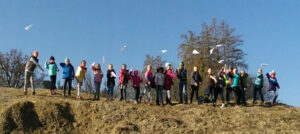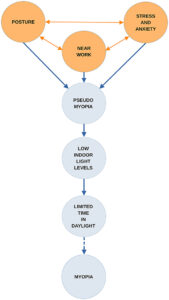4 November 2025
Children’s Eyesight and Daylight
A child’s eyesight is a delicate and precious thing. Yet the modern world places unreasonable demands on children’s vision. Myopia, otherwise known as near-sightedness, or short-sight, has emerged as a major health problem. Currently about one-third of children and adolescents worldwide are myopic and by 2050 this may rise to 40 percent if current trends continue. Myopia is not a safe condition. Young people with myopia can suffer emotional problems. And any level of myopia, moderate or severe, raises their risk of cataracts, macular degeneration, glaucoma and other sight-threatening eye disorders in later life.
Some children are far more likely to damage their sight than others. Much depends on how, and where they are brought up. Those who do not go to school are unlikely to become near-sighted; although a few may inherit high myopia. Children most at risk live in cities. They are in education systems that encourage highly competitive, intensive study. And, as a consequence, they spend very little time outdoors in daylight. In East and South East Asia there has been a `Myopia Boom’. As many as 90 percent of children in urban areas finish high school with blurred vision and need lenses to correct it. Also, the age at which children are becoming short-sighted is falling. The earlier the onset, the more rapidly myopia progresses and the more severe it can become.

(Photo: Gabriele Lauterbach)
An outdoor lesson on flight in Norway
Research shows that children who spend more than 2 hours outdoors in daylight every day can reduce their myopia risk by about 30-50 per cent. Some of the worst affected countries now have initiatives in place to encourage outdoor activities during the school day. This is not new. When compulsory state education was first adopted during the 19th century, school myopia followed. Records from the 1860s show that in Germany’s High Schools, the incidence of myopia increased from class to class and by the final year over 50 per cent of children had damaged their sight. Daylight seemed to be the answer and so school architecture and planning changed. The aim was to make sure children had plenty of daylight in classrooms and then, between lessons, more of it outdoors on playgrounds and sports fields. Although widely adopted, this approach was never properly assessed and was eventually abandoned in the 1960s.
Recent research from Norway shows high academic standards can be achieved in schools without the excessive levels of myopia reported elsewhere. Although not arranged to do so, the Norwegian education system protects children from the worst of myopia. It combines a more relaxed system of learning with extended periods of outdoor activity. So, the two most important risk factors for myopia – intensive education and lack of daylight – are largely absent. But it is still not clear why they cause myopia. Mechanisms in the eye are combining to trigger its onset and daylight can stop them. Until we know what they are and how they interact, finding an effective way to stop the Myopia Boom remains a challenge.
Hypothesis: The combined effects of suggested factors leading to myopia

(Hobday R, Aarts M, et al. 2025) © 2025 Hobday, Aarts, Cajochen, Maierova, Münch, Osterhaus, Stefani and Wulff.
References
Hobday R, Aarts M, Cajochen C, Maierova L, Münch M, Osterhaus W, Stefani O, Wulff K. Myopia and daylight-A combination of factors. Front Med (Lausanne). 2025 Jul 2;12:1481209. https://doi.org/10.3389/fmed.2025.1481209
Hobday R. Outdoor Learning and Children’s Eyesight. In: Jucker, R., von Au, J. (eds) High-Quality Outdoor Learning. Springer; Cham: 2022. https://doi.org/10.1007/978-3-031-04108-2_11
Liang J, Pu Y, Chen J, Liu M, Ouyang B, Jin Z, Ge W, Wu Z, Yang X, Qin C, Wang C, Huang S, Jiang N, Hu L, Zhang Y, Gui Z, Pu X, Huang S, Chen Y. Global prevalence, trend and projection of myopia in children and adolescents from 1990 to 2050: a comprehensive systematic review and meta-analysis. Br J Ophthalmol. 2025 Feb 24;109(3):362-371. https://doi.org/10.1136/bjo-2024-325427
Yang YC, Hsu NW, Wang CY, Shyong MP, Tsai DC. Prevalence trend of myopia after promoting eye care in preschoolers: a serial survey in Taiwan before and during the Coronavirus Disease 2019 pandemic. Ophthalmology 2022;129:181–90. https://doi.org/10.1016/j.ophtha.2021.08.013

Comments